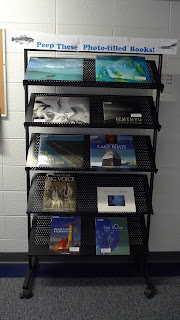Here are descriptions of three books featured in the display:
Ice: Portraits of Vanishing Glaciers by James Balog and the Extreme Ice Survey Team (2012)
"A never-before-seen look into the forbidding environment of glaciers, this book celebrates a realm of magnificent endangered beauty. Since 2005, renowned nature photographer James Balog has devoted himself to capturing glaciers and documenting their daily changes. These stunning images are a celebration of some of the most extraordinary natural formations on earth, as well as a dramatic and timely demonstration of the stark consequences resulting from global warming—from Alaska to Iceland to the Alps." (excerpted from the book's description)Distant Shores: Photographs from Lake Superior and Lake Michigan by Richard Olsenius (1990)
"Richard Olsenius is a 20-year veteran of newspaper and magazine photography and filmmaking. He has won numerous awards including the prestigious World Press Photo award. In 1987, Olsenius spent eight months on assignment for National Geographic Magazine covering the Great Lakes. Distant Shores is an outgrowth of that assignment..." (excerpted from the books "About the Authors" page)Water Light Time by David Doubilet (1999)
"Beneath the world's waters lie landscapes, species, vegetation and populations as diverse and splendid as those on land, yet these kingdoms have been explored by few. is an extraordinary look at the work of David Doubilet, an artist and diver who pioneered the medium of deep-sea reportage to become widely acclaimed as the world's leading underwater photographer...From the waters of the Galapagos to the Red Sea, from the Pacific shores to the fresh waters of North America, "Water Light Time" includes over 25 years of Doubilet's work, and reveals the mesmerising beauty of more than 30 bodies of water." (excerpted from the book's dust cover)If you are a Wisconsin resident and would like to check out this or any other book, please fill out our book request form. If you are a UW student, faculty or staff, please request books through the Library Catalog.










